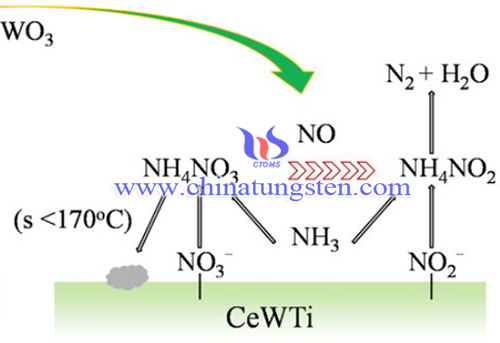Sol-Gel Synthesis of WO3-CeO2-TiO2 Catalyst with Ammonium Paratungstate
- Details
- Category: Tungsten Information
- Published on Wednesday, 12 May 2021 04:53
Nitrogen oxides (NOx) have become one of the main atmospheric pollutants with the increasing consumption of fossil fuels as well as the rapid growth of the automobile exhaust emissions. NOx causes serious environmental problems such as acid rain, photochemical smog, and ozone depletion.

The most conventional SCR catalyst is V2O5 /TiO2, which has high efficiency and strong resistance to SO2 poisoning. however, there are still certain significant drawbacks, such as the toxicity of V2O5 to the environment, relatively narrow temperature range, and low activity at low temperature.
sol-gel synthesis of WO3-CeO2-TiO2 catalyst has been conducted with ammonium paratungstate as material, which has excellent low-temperature activity. The experimental procedure is as below:
Cerium nitrate hexahydrate, ammonium paratungstate (APT) and commercial TiO2 powders (DT-51) were mixed in deionized water according to a mass ratio of CeO2: WO3: TiO2 = 5:5:90. And then citric acid (AR, Aladdin) and nitric acid were added. The solution was sufficiently stirred in a water bath and heated at 80 °C until a porous gel was formed. The gel was dried at 110 °C in an oven overnight. The resulting product was subsequently subjected to decomposition at 300 °C for 1 h and calcination at 600 °C for 3 h in a muffle. Finally, the samples were crushed and sieved to 40–60 mesh for catalytic activity measurements.

In summary, sol-gel synthesis of WO3-CeO2-TiO2 catalyst has been conducted with ammonium paratungstate as material, which has excellent low-temperature activity. Addition of WO3 provides more acid sites which accelerate the reaction between NH4NO3 and NO to get a superior low-temperature activity.
- APT Manufacturer & Supplier, Chinatungsten Online: ammonium-paratungstate.com
- Tungsten News & Prices of China Tungsten Industry Association: www.ctia.com.cn
- Molybdenum News & Price: news.molybdenum.com.cn
- Tel.: 86 592 5129696; Fax: 86 592 5129797; Email: sales@chinatungsten.com



 sales@chinatungsten.com
sales@chinatungsten.com